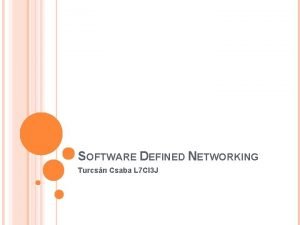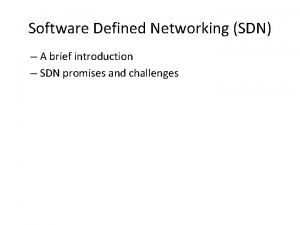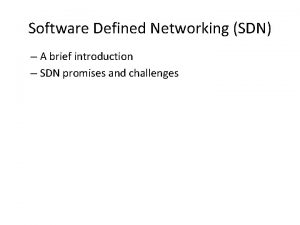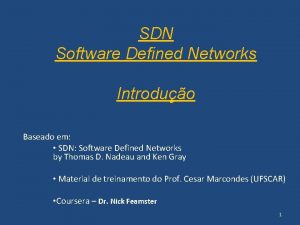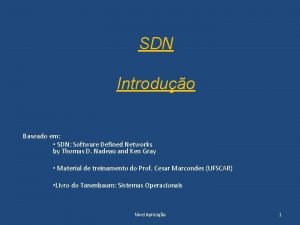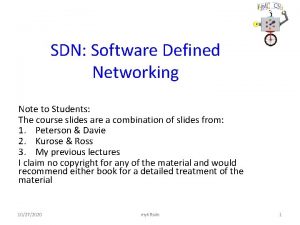Prepare for Software Defined Networking SDN SDN will










- Slides: 10

Prepare for Software Defined Networking (SDN) SDN will revolutionize networking (when it matures) Info-Tech's products and services combine actionable insight and relevant advice with ready-to-use tools and templates that cover the full spectrum of IT concerns. © 1997 - 2012 Info-Tech Research Group 1

Introduction Enterprise networks are becoming increasingly complex due to the advancement of networking technologies and hardware appliances in the past decade. Discover the capabilities of software defined networking (SDN) as an emerging approach to modernize your network. This Research Is Designed For: This Research Will Help You: üOrganizations planning for network üUnderstand the concept and business drivers modernization in the coming years. üCTO’s, infrastructure managers, and network professionals looking to understand the upcoming impact of SDN. üCIO’s who want to prepare their organization for evaluation and eventual deployment of SDN. of Software Defined Networks. üAssess the state of SDN standards and technologies. üDecide when to start investing in SDN. üPlan for SDN’s impact on people and processes. Software Defined Network technologies are getting substantial investment from leading vendors and close attention from academic researchers. While “version 1” is now appearing in the market in late 2012, the path to enterprise-tested, mature “version 2” products will be short. Info-Tech Research Group 2

Follow the Info-Tech Enterprise Network Roadmap The enterprise network is the information highway. 1 2 Craft a Converged Data Center Network Strategy Determine if a converged data center network is the right fit for your enterprise. Vendor Landscape: Data Center Networking Gain insight into which vendor best aligns with your organization’s data center needs. 7 3 Vendor Landscape: Wireless LAN Understand the capabilities of WLAN vendors and identify which provide the most value. 4 Network Strategy 5 Vendor Landscape: Enterprise LAN Implement an enterprise LAN solution that fits into the larger network strategy. Info-Tech Research Group Vendor Landscape: WAN Optimization WAN optimization can enhance the WAN by compressing traffic and deduplicating data. 6 Prepare for Software Defined Networks (SDNs) This solution set will provide an understanding for SDN and discuss its impact to the existing network. Build the Enterprise Access Network of the Future Take advantage of technological trends by cutting the cord on wired access networks. 3

Executive Summary SDN promises to alleviate the limitations of traditional networks • Hardware that dominated the network landscape until recently are being repositioned. Virtualized servers and storage are rapidly being introduced to the network, but traditional networks are incapable of realizing the full potential of virtualization. • Software defined networking (SDN) emerged as an approach to modernize the network with cost efficient and streamline concepts. • SDN promises many capabilities and flexibility that are unseen in traditional networks; however, current SDN solutions are barely tested and immature for mainstream deployment. Begin building the case for SDN • Even though SDN is still in its infancy, begin thinking and evaluating the impacts SDN has on your business. Pitch SDN enhancements as business capability enablers. • SDN introduces software risks to the network that are dynamic and numerous compared to the relatively static and predictable risks of traditional networks. Ensure your risk mitigation strategy is flexible and maintain a high risk assessment throughout the SDN project. Wait for market maturity and commoditization • Through open standards and quick configuration processes, SDN enables organizations to integrate solutions from multiple vendors into their network. • Best SDN practices to fill people, process, and technology gaps are still being written by early adopters. Info-Tech Research Group 4

Re-think the network’s role in IT if agility is suffering Traditional networks are the essential, but restrictive, foundations of an organization’s infrastructure. Traditional networks worked well in the past… • Hardware-based networks have historically shown that they were stable, and reliable. ◦ Operational capacities were quickly regained after a power loss without significant external interventions or software start ups. ◦ ◦ They were consistently operational in static environments. “Set it and forget it” management mindset was applicable. . but they are rapidly becoming a bottleneck for IT • Servers and storage infrastructure are now becoming virtual but their agility is constrained by the rigidity of network configurations. • Network utilization is low, despite the fact that parts of the network are overwhelmed at various times. • Complex and dynamic networks are costly and time consuming to manage. Traditional networks constrain some common IT activities: • Migration of virtual devices and servers from • • one location to another Scaling out servers Reconfiguring network devices Modeling network traffic Adopting advancements in system-hosting technology (i. e. : Cloud and virtualization) Don’t rush to the conclusion that your physical infrastructure needs to be modernized. Determine if the added capabilities of modern networks are priorities or bells-and-whistles. Info-Tech Research Group 5

Align SDN initiatives with your business goals A successful SDN initiative needs to take existing infrastructure, management processes, and business requirements into account. • Previously, network investments, replacements, and upgrades were often seen as tactical and ad-hoc. This approach to network management is appropriate for traditional network architecture. • SDN has the potential of impacting both business and IT. Therefore, SDN must align with business and IT drivers to generate buy-ins and continual support. ◦ Consider the business drivers and implications as you prepare, evaluate, and implement SDN. ◦ Deviating away from business and IT directives increases the risk of incomplete or ineffective initiatives. • Network administrators need to take a proactive approach to ◦ IT agility. Networks must be stable and reliable. Business operations should not be affected by network disruptions. It’s where you can create new value. . . It isn’t necessary changing your networking line items, it’s how you change your overall IT line items. ◦ Change management. Sufficient pre-testing must occur for network-dependent changes so downtime is minimized. - Matthew Palmer, Partner and Co-curator, SDNCentral contribute to the overall business strategy: Info-Tech Research Group 6

Evaluate the current state of your network to see if SDN is the right fit for your organization Perform an analysis of your network to assess operational and risk factors before embarking in SDN can have little value to an organization’s networking needs if company policies and industrial standards restricts its full potential. Consider the following organizational attributes when evaluating your network: • Infrastructure Composition – networks can be composed of a mixture of virtual and physical infrastructure in a localized or off-premise location. • Network Complexity – intricate networks present a network mapping challenge due to the significant number of possible communication paths from source and destination. • Growth of Network – virtualization enables networks to grow, scaleout, or contract dynamically and on-demand. • Capacity and Utilization – performance is affected by the amount of available resources in the network allocated to specific flows and the efficiency of their use. • Proprietary Infrastructure – proprietary hardware limits the opportunities to reach out to more cost efficient or streamlined solutions. • WAN and LAN – traffic flow routing and mapping are influenced by the security and latency at various access points of the network. Info-Tech Research Group Info-Tech Insight The wireless network is becoming businesscritical in most organizations, making the management of separate wired and wireless networks redundant. Wireless networks enables collaboration and is compatible with BYOD policies. Refer to Info-Tech’s Build the Enterprise Access Network of the Future solution set for more information. 7

Prepare for the commoditization of network hardware Standards and rapid configurations lay the groundwork for interoperability and commodity hardware in the network. Proprietary Hardware Commodity Hardware Situation: The physical infrastructure of traditional networks were primarily proprietary, hardware exclusive to and controlled by a single company or subjected to licensing or patents. Situation: SDN gives organizations the opportunity to implement solutions not native to their physical infrastructure due to open technologies and easy configurations; thereby, enabling a multi-vendor network. Effects on the Organization: • Proprietary hardware limits the opportunities for organizations to reach out to more cost efficient or streamlined solutions. • Organizations may need to wait until vendors upgrade their hardware before modernizing their network. Effects on the Organization: • SDN’s automated remapping and open APIs reduce the effort and resources needed for reconfigurations. • Organizations can become more cost efficient and productive; however, management costs may increase during the transition to commodity hardware. At the end of the day, nobody can procure a switch cheaper than [a key proprietary vendor] from the contract manufactures because of their volume. - Matthew Palmer, Partner and Co-curator, SDNCentral Current SDN solutions are expensive, complex, and barely tested. Assess the new offerings from your existing vendors to maximize reuse of existing components. For a full network refresh, consider waiting for market maturity and commoditization. Info-Tech Research Group 8

Conclusion Understand SDN • Software defined networking (SDN) is defined as a network architecture where the control and data planes are decoupled. • SDN offers several key benefits over traditional physical networks: abstraction, flow optimization, resource utilization, and virtualization. • The SDN architecture comprises of three layers: applications and data centers, control plane, and physical network architecture. Each layer communicates with each other through APIs. Emerging SDN Solutions • Vendors are beginning to roll out early versions of their SDN solutions. See what these vendors are offering. • Open. Flow is currently the dominant standard for SDN communication protocols and SDN architecture. Develop the Case for SDN • Applicable use cases and proof-of-concepts have barely been revealed. However, organizations should begin evaluating the potential business value and impact from adopting SDN. • Organizations starting to develop the case for SDN must ensure SDN aligns with business drivers, potential costs and benefits are understood, risks are realized, performance metrics are established, and the existing network is assessed. How and When to Start Investing in SDN • SDN enables organizations with proprietary network hardware to reach out to more cost efficient solutions. • Network architecture must be a forethought because the benefits of SDN is contingent on the network structure and connections of network components. • Noticeable version 1 gaps are being realized by early SDN adopters. Wait for SDN to mature and these gaps to be filled. Info-Tech Research Group 9

Info-Tech Research Group Helps IT Professionals To: ü ü ü Quickly get up to speed with new technologies ü Manage business expectations ü Justify IT spending and prove the value of IT ü Train IT staff and effectively manage an IT department Make the right technology purchasing decisions – fast Deliver critical IT projects, on time and within budget Sign up for free trial membership to get practical solutions for your IT challenges • “Info-Tech helps me to be proactive instead of reactive – a cardinal rule in a stable and leading edge IT environment. - ARCS Commercial Mortgage Co. , LP Toll Free: 1 -888 -670 -8889 Info-Tech Research Group www. infotech. com 10








